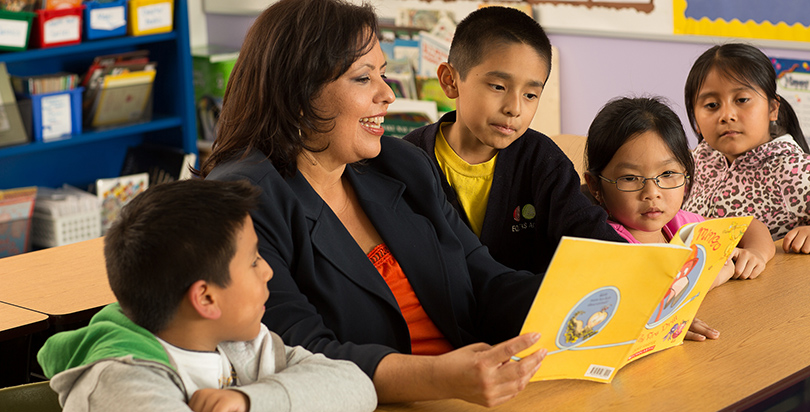Can Mónica García Unify L.A.? How the Longest-Serving School Board Member Cruised to Her Fourth Election Win

This article was produced in partnership with LA School Report; see LASR’s complete coverage of the 2017 school board race.
Mónica García started this month’s school board meeting day with an 8 a.m. visit to one of her schools. At 9 she joined the board’s closed-session meeting, eating her lunch while it extended right up to the public afternoon meeting. Between votes, she could be found talking to concerned parents in the hallway outside the Beaudry headquarters auditorium. She hugged most of the teachers and parents, knew many of them by name, and offered suggestions and plans of action for some of their concerns.
“It’s always like this for me,” said a breathless García, who took time for LA School Report along the way. “I’m always listening, always hearing about the struggles, just listening to people. I represent a struggling district, and we have been the underdog of a district that is struggling overall. My district struggles together, despite our diversity of opinions, and that is what brings us together.”
García’s ability to bring people together has made her the longest-serving member of the board, where she has also served as president. It’s what she credits for her March 7 election win — her fourth. She handily beat her two opponents with 56 percent of the vote, avoiding a runoff like there will be in May in two other LA Unified board races. Due to term limits, this will be the last time García can be elected to the District 2 seat, which she has held since 2006.
Her legacy on the school board and her influence in the Latino community citywide could help usher in a new pro-reform era on the school board, particularly if she endorses in the two runoff races — something she said she is not ready to do yet. But with those two seats, she would have enough votes to push through her goals for her final term on the board.
Incumbent Steve Zimmer, the current school board president, is up against reform candidate Nick Melvoin in District 4, and two newcomers are vying for the District 6 seat: reform candidate Kelly Gonez and labor-backed Imelda Padilla.
“I am very much living the joy right now of our successful District 2 campaign, and I appreciate all the folks running for school board, and whoever gets on, I want to be able to work with them,” García said. “I know that I am not in the political majority right now.”
She recognizes that it takes four of the seven elected board members to get anything done. And she is admittedly in the minority right now, with only two reformers on the board. However, that could quickly change in May.
García, who is seen as a pro-charter advocate, remembers when a majority of her fellow board members tended toward her views. That era ended two years ago when Tamar Galatzan (whom García strongly endorsed) lost her re-election bid to Scott Schmerelson, who sits to García’s left on the horseshoe at the school board meetings. Only one of her fellow board members (Ref Rodriguez, a charter advocate representing District 5) came out in support of García’s re-election bid.
“It’s my last term, and I’m interested in a productive board and I want to work well with whoever is elected,” García said. “On July 1st [when the new board is installed] we get a whole new chance of creating a relationship that can serve our families and this district well. We do have differences of opinions.”
She quoted outgoing chief financial officer Megan Reilly, who said at the board meeting, “We all care about the kids, we just disagree on the how. But it is also about the board being able to agree on what the board’s business is and how will the board conduct itself.”
For now, García doesn’t intend to endorse any candidate for the other two districts, although it’s become a battle between pro- and anti-charter concerns that is getting national attention. She knows she is not part of the political majority but said it’s not just about charters.
Her district has the most charter schools, 72, with the next highest concentration being in the San Fernando Valley, at 53. There’s a reason for that, she said.
“When I got elected, it was really about change or status quo,” García noted. “Schools were way overcrowded and there was forced busing. The data was very clear that we could not support the status quo.”
Parents were demanding change. So charters moved in to offer options. García has supported them, but she has also worked with the plethora of community groups striving to improve the education and opportunities of the mostly poor or immigrant neighborhoods.
“In my district, the mission and movement that I’m a part of is not about the tension of one way or other [concerning charters], it’s about the tension around serving all kids and not serving all kids,” García said.
“And the wonderful thing about elected life is you don’t need 100 percent,” she added.
She never received the backing of the teachers union, UTLA, but does get the backing of SEIU and police and other workers unions.
(More from LA School Report: Meet an LAUSD school board candidate — District 2’s Mónica García: ‘Pleased with the progress but not satisfied’)
Only the third Latina to be elected to the LA Unified school board, where 74 percent of the school population in the entire district is Latino, García said she has kept the pulse on her community by just listening to people. Her district covers Boyle Heights, East Los Angeles, downtown, Koreatown, and South Los Angeles, and every single one of her schools is Title 1, meaning they serve predominantly low-socioeconomic families.
When García started on the board, 227 schools had year-round schedules because of overcrowding, and 16,000 students were bused out of their neighborhoods. Belmont High, in her district, had a 24 percent graduation rate, and a study at the time criticized the district because only 39 percent of Latinos were graduating from high school. (Now the graduation rate for Latinos is at 76 percent.)
“At that time, there was a lot of distress in the community around LAUSD not being accessible, and just chronic underperformance and a real deep frustration,” García said. “There were a lot of nonprofits that were motivated and active through the A-G [mandatory high school requirements] movement and in discipline. A lot of community-based organizations were on the front lines dealing with the issues of translating government, policy, and funding, and connecting with the people.”
Her district was an underdog, and that brought people together in ways that are different from those in other districts.
During school board meetings it’s not uncommon for García to come down from the horseshoe to talk to families, students, and even protesters in the audience during the meeting. Former school superintendent Ramon Cortines even ribbed García for her gregarious nature while on the board. She never shied away from a confrontation, even welcoming and supporting demonstrations that disrupted meetings.
“In District 2 we have a coalition of diversity of thought; we don’t all agree,” García said. “It’s just that we do agree that we’re stronger if we’re in it together. It’s worth it for us to struggle together.”
She said she knows that education remains an important part of her community, regardless of income level or immigration status. A labor union survey showed that education was more important to people in her district than salary improvement or immigration.
“And LA Unified has done a lot of good things,” García said. Changing the mindset of the board is important, and “at one point the district would say the poor achievement is because of the kids. Now, we say that a school is not achieving, so we figure out how to change the system, figure out a different resource strategy, and change the leadership team.”
Getting through a recession, passing a $7 billion school bond, saving teachers’ jobs, enhancing food programs, finding good health care programs, all while increasing test scores and graduation rates — that is a tribute to the district’s successes, García explained.
“Is the district doing what it is supposed to be doing?” García asked. “The changes that we have been looking for have been greater academic achievement, and that means we have to be interested in organizational health. Being on the board is hard, but it is about having to bring the hopes and dreams for the community that I know, and to not allow people to say kids don’t want to succeed or that kids can’t. It’s simple in that way.”
When the district had to cut 10,000 jobs and lose $2.7 billion due to the recession and falling enrollment, people stepped up to help, García said.
“We had to shut down parts of the bureaucracy,” García recalled. “Charters were just one of the solutions. People came, whether they were trying to offer an alternative instructional strategy, like Academia Semillas del Pueblo Xinaxcalmecac [an indigenous Mexican public charter school], or whether they were coming to relieve the overcrowding quickly, like Oscar De La Hoya Ánimo Charter High School, in Boyle Heights with Green Dot, or if they were trying to serve a community like the homeless kids at Para Los Niños Charter Middle School, where they increased their scores by 60 points in one year and it was one of the highest scores in District 2. These were alternatives that were necessary to accelerate the pace of improvement.”
García said she isn’t sure she should weigh in on the contested school board seats because it is more important for her to educate people about the election and let them figure out what LA Unified should be in 10 years. She said she has talked and worked with all the candidates.
“I hope that when it’s over, the people who are engaged in this next election are proud of the vision and agenda they have put out,” García said. “Those candidates are all leaders.”
García stressed that she wants to be able to work with whoever wins the May runoffs.
She added, “There’s a real conversation going on about the district right now. It’s not limited to whether you support A or you support B. It’s about the future of children.”
Get stories like these delivered straight to your inbox. Sign up for The 74 Newsletter

;)
